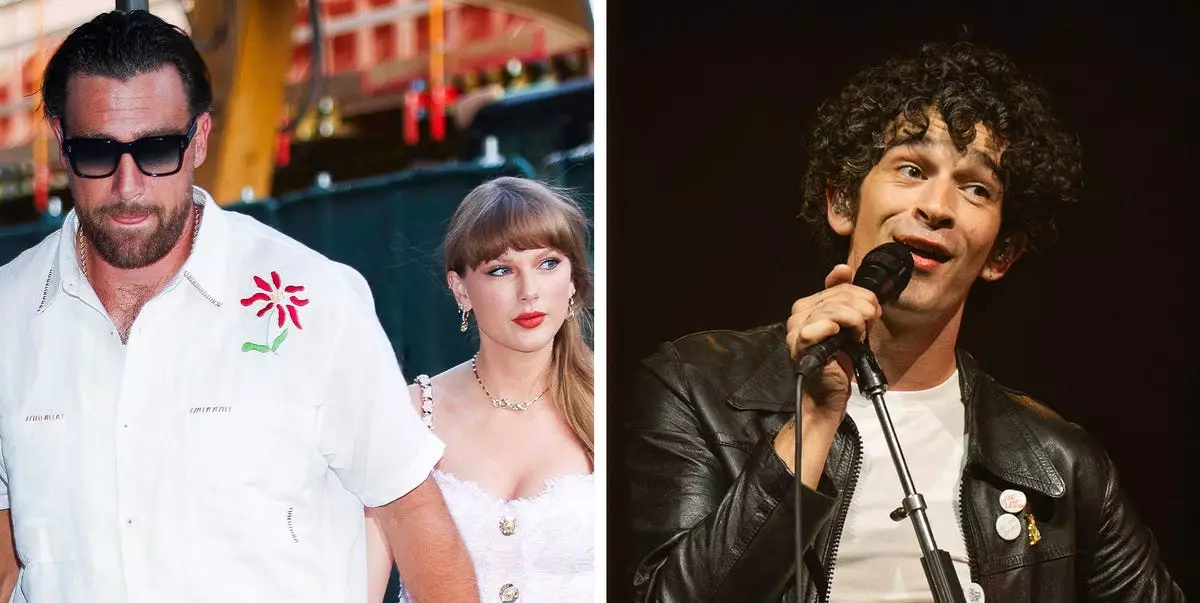In the world where personal lives and artistic expressions often intertwine, few moments capture public attention like the recent incident involving Matty Healy, lead singer of The 1975, and his ex-girlfriend, global pop icon Taylor Swift. During The 1975’s Glastonbury set, Healy seemingly took a pointed jab at Swift’s recent album, *The Tortured Poets Department*. His sardonic self-endorsement as the “best songwriter of my generation” and “a poet, ladies and gentlemen” was laced with irony and seemed less a humble brag and more a deliberate, theatrical provocation. Given Swift’s album themes—many reportedly tied to their breakup—the jab wasn’t lost on the audience or fans, who quickly noted the timing and wording as an implicit reference to her work.
This incident underscores a classic feature of celebrity dynamics: how personal narratives are weaponized or aired through art and public performances. Healy’s decision to make this veiled comment, especially at Glastonbury—a storied and globally livestreamed event—reflects a complicated blend of lingering feelings, rivalry, or perhaps a final, performative assertion of his own creative identity in the shadow of Swift’s overwhelming pop dominance.
Taylor Swift’s Response: A Study in Quiet Strength and Strategic Visibility
Swift’s reaction—or more correctly, her lack of a verbal response—speaks volumes. Instead of engaging in a public feud or issuing a rebuttal, she chose a subtly potent approach: being photographed on a date night with boyfriend Travis Kelce, an NFL star. Their public hand-holding and coordination in white ensembles during a dinner outing in New York sent a clear, nonverbal message. The age-old adage “living well is the best revenge” perfectly encapsulates Swift’s response strategy.
This is a textbook example of how celebrities can control narratives by choosing when and how to respond—or consciously, when not to. By simply doing what makes her happy and moving forward, Swift not only shifted media focus away from Healy’s provocations but reinforced an image of personal growth and emotional resilience. It’s a stark contrast to Healy’s confrontational bravado, positioning Swift as composed and unshaken.
The Impact of Public Breakups on Artistic Personas
The fallout between Swift and Healy illustrates how breakups, especially among public figures, become fodder for public consumption and artistic inspiration alike. Swift, known for translating her personal experiences into chart-topping albums, didn’t shy away from embedding her emotional journey into *The Tortured Poets Department*. The narrative reportedly includes introspective songs that reveal her side of the story, something Healy’s snide remarks seem to challenge—perhaps out of ego or a desire to reclaim public interpretation of their saga.
Yet, this interplay also raises questions about maturity and the effectiveness of airing grievances publicly when emotions are still raw. Healy’s sarcastic proclamation at Glastonbury, rather than earning respect, risked sounding petty, especially compared to Swift’s dignified silence and forward-looking life choices. It’s an example of the importance of timing and tone in public discourse—especially for artists who must balance personal vulnerability with public performance.
The Role of New Relationships in Rebuilding Identity
Swift’s new relationship with Travis Kelce is not just tabloid fodder but a meaningful phase of her life signaling personal stability post-breakup. Their commitment to spending time together amid demanding schedules, along with public appearances that suggest comfort and confidence, convey a narrative of healing and growth. The notion that Swift believes Kelce might be “The One”—though marriage remains off the immediate table—adds depth to her story beyond the music and media spectacle.
This progression highlights a vital but often overlooked aspect of celebrity culture: building a private life that can withstand public scrutiny and speculation. While Swift’s music processes past relationships, her current partnership symbolizes moving forward not just emotionally but also in life’s practical rhythms. It challenges the expectation that celebrity breakups must end in public acrimony or definitional moments of bitterness.
Media and Public Perception: The Battle for Narrative Control
Lastly, the swift media pivot following Healy’s Glastonbury remarks reflects how public figures jockey for narrative dominance in an age of instantaneous information and viral moments. Swift’s well-timed public appearance effectively overshadowed Healy’s provocations, reminding us how media coverage often favors the person who projects positivity and control over drama and negativity.
This tug-of-war for attention between two high-profile artists also reveals the pressures celebrities face to curate their image with relentless precision. Far from incidental, such moments of “non-response” become strategic moves. It’s a reminder that sometimes the most powerful comeback isn’t a fiery retort but the silent act of thriving amid tension.
This episode between Healy and Swift is more than mere tabloid drama: it’s a compelling study in emotional navigation, artistry, and the modern celebrity’s ongoing battle to maintain dignity while living life in the unforgiving spotlight.

